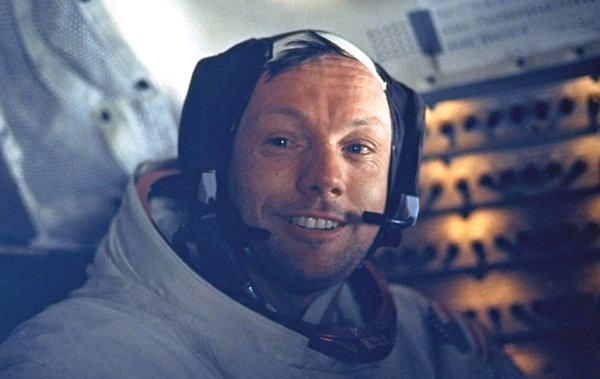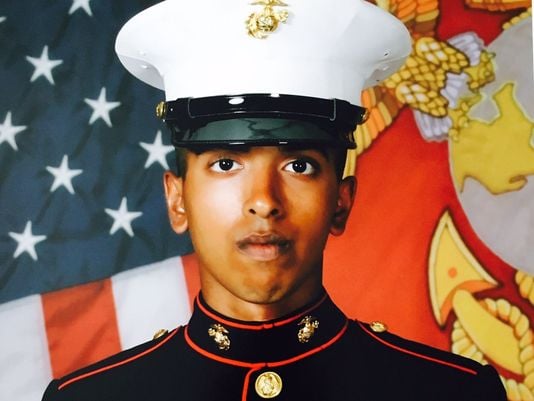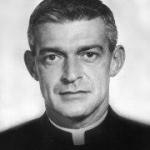Over at Mental Floss, there’s a great recap of the life and career of Neil Armstrong. I’ll provide you the link in a moment. But first I wanted to share the following narrative of the landing as told by astronauts Alan Shepard and Deke Slayton (with able help by writers Jay Barbree and Howard Benedict) in their book Moon Shot: The Inside Story of America’s Race to the Moon. This is a lot like an episode from Paul Harvey’s The Rest of the Story. We begin at 1300 feet and falling…
Thirteen hundred feet above the moon’s surface, Eagle began it’s final descent. Flames gushed downward as the craft slowed. Neil Armstrong had flown his mission right along the edge of a razor. He and Buzz (Aldrin) functioned as one mind. Now they were doing more than falling moonward. They were so close Neil had to fly this ship. He punched PROCEED into his keyboard. The computer would handle the immediate descent tasks. Buzz would back up both man and electronic brain so Neil could switch his eyes and senses to flying in a vacuum.
Both men looked through the triangular windows to study the surface of the moon. They’d made simulated runs so many times they knew their intended landing site as well as they did familiar airfields back home. Almost immediately they noticed that they weren’t where they were supposed to be.
Damn!
Eagle had overshot the landing zone, Home Plate, by four miles. A slight navigational error and a faster than intended descent speed accounted for Eagle missing its planned touchdown site in the Sea of Tranquility.
Neil scowled at the surface still rising toward them. Boulders surrounded a yawning crater wider than a football field and Eagle was running out of fuel and headed straight for it. There was no time to waste.
In the lunar void there was no gliding to conserve fuel. Eagle was only dead weight in a vacuum. There also was no opportunity to orbit again for another try at landing. Their only chance to succeed was to land now.
Neil Armstrong gripped the hand controller in his fist, firm and strong, with a touch honed by years of flight in jets and rockets. He knew the “thin edge” well, both in atmosphere and in hurtling in orbit about his home planet. Now he had to fly as he’d never flown before. Knowledge, experience, skill. X-planes and spacecraft, everything coming to this one moment, this place above desolation.
Neil Armstrong needed to hand-fly the rest of the way.
His fingers alternately tightened and eased his grip on the controls. Eagle was sailing down at twenty feet per second. Neil nudged the power, slowing to nine feet per second.
He needed to feel his ship.
He attuned his senses to the rocking motions, the nudges, and the skidding motions of sixteen small positioning thrusters that kept the Eagle aligned through its descent. A level touchdown was their ticket to safety, survival, and the return home.
Mission Control listened, mesmerized and awed, to the voices closing in on lunar soil. Neil guided the bird. Buzz watched the landing radar, called out numbers that bespoke volumes of split-second judgement and maneuvering.
“Five hundred forty feet [height above the surface], down at thirty [ feet per second]…down at fifteen…four hundred feet, down at nine…forward…three hundred fifty feet, down at four…three hundred feet, down three and a half…forty-seven forward…one and a half down…thirteen forward…eleven forward, coming down nicely…two hundred feet, four and a half down…”
It sounded better than it was. Neil balanced the bug-like machine on a solid cone of fire. Eagle was now in a directed drifting mode. There was no place to land. Rocks, huge boulders, and deadly craters were strewn everywhere.
Mission Control was dead silent.
Neil fired the Eagle’s right bank of maneuvering jets. The Eagle scooted across rubble billions of years old.
There! There beyond a field of boulders, slightly to the left—the rocks were thinning out, revealing a smooth, flat area. The new Home Plate.
The numbers ghosted back to earth.
“Five and a half down…5 percent…seventy five feet…six forward…ninety seconds,” Buzz chanted. “Ninety seconds.”
He had been carefully watching the fuel gauge, as had Mission Control. Ninety seconds of fuel left in their tanks for the descent. The Eagle needed to land in ninety seconds or—
No one wanted to think about it. If the engine gulped its last surge of fuel before they touched down, this close to the moon, they would crash, falling to the surface without power.
Buzz knew there was plenty of fuel for Eagle’s ascent stage. But that was needed for an abort, or to get off the moon after a successful landing. If the descent fuel was exhausted before the ascent engine kicked in on an abort, it would be too late.
Neil didn’t bother with ifs and could-bes. He’d flown this same approach hundreds of times in the ground simulators and in the clumsy, jet-powered lunar landing trainers.
At such a moment a pilot flies. Everything else is shoved aside. Neil could feel what fuel they had left. His eyes and mind and hands worked beautifully with orchestrated skill. He would bring Eagle down and bring her down level.
It would not be easy. Eagle was now top-heavy, the ascent stage still crammed with fuel, the tanks of the descent stage perilously close to empty. Neil and Buzz might not have worried about setting down at a steep angle, but they needed to remain on an even keel. Otherwise, Eagle could hit the surface tilted, out of position to relaunch itself for its lifesaving rendezvous with the command ship Columbia.
Slayton, Shepard, and everyone else in the control center were gritting their teeth. Anxious and concerned, all they could do was watch. The fate of the mission was in the hands of the two astronauts.
Charlie Duke sounded the warning, “sixty seconds.”
There was one minute of fuel left. In sixty short seconds the rocket power flaming beneath the Eagle would burn out. The tanks would be empty. An abort would need to be initiated seconds before that happened if Eagle was not to crash.
Balancing on slashing flames and banging thrusters, Neil Armstrong calmly aimed for his new landing site. The Eagle’s commander kept one thought uppermost in his mind. Fly his machine. That was it. Simple, exquisitely to the point. Fly it down the invisible corridor. Eagle swayed gently from side to side as the thrusters responded to Neil’s commands.
Far away, down through the atmosphere and the clouds, enclosed within Mission Control, the flight controllers were almost frantic with their inability to do anything more to aide Neil and Buzz.
Deke Slayton knew they had to leave it to the pilots and “final approach.” A Eagle skittered over boulders and across craters, only Neil Armstrong’s judgement counted. He was there. He was flying. But the clock kept ticking, the precious remaining seconds slipping away like grains of sand in an hourglass. Charlie Duke looked at Deke. Charlie held up both hands, palms out. He didn’t need to voice the question. Gene Kranz did it for him in the internal communications loop. Everyone heard his words.
“Capcom, the is Flight.” Kranz’s words to Deke were firm and steady. “You’d better remind them there ain’t no damn gas stations on the moon.”
Charlie nodded and keyed his mike. A timer stared at him. “Thirty seconds,” he said. An entire speech in two words.
“Light’s on.”
This time the announcement was from Buzz Aldrin as he watched an amber light blink balefully at him from the master caution-and-warning panel. It was the low fuel signal.
Buzz eyed another button, half afraid he might have to punch it. It read ABORT STAGE.
Neil didn’t respond. There was no time left for word exchanges. All his senses, brought to needle-point sharpness at this moment, concentrated on the multiple tasks involved in settling Eagle on the moon. He searched the ground below, experienced eyes seeing, judging, deciding. The lunar landing vehicle had come out of the vacuum sky like a meteor. It was now transformed. It was more helicopter than spaceship or airplane, but its lifting and hovering force was fire, transparent thrust.
Eagle’s descent engine burned fiercely and silently in the void.
Buzz intoned the numbers like a priest, steady and clear, voicing the final moments flashing away. He had confidence in Neil’s ability. But his hand did not stray far from the ABORT STAGE button.
“Seventy-five feet,” he called out.
“Six forward… ”
“Light’s on…down two and a half…forty feet, down two and a half…”
Eagle was now slipping downward fifty feet above the moon. Men and machine embraced a new level of potential danger. This close to the surface, they had no margin for error. If their space vessel failed them, or if they ran out of fuel, they would not have time to abort. If they ran into any problem this close, there would be no time for circuits and solenoids and explosive charges to separate the Eagle from its lifeless descent stage, no time for fuel to stream through lines in the ascent stage’s combustion chamber beneath their boots, no time for fuel to ignite and hurl them upward before they crashed.
Time was their enemy.
“Thirty feet…”
“Two and a half down…”
Then, the magic words!
“Kicking up some dust…”
“Faint shadow…”
So close now! So close! There was no turning back! The door behind them had closed.
“Four forward… “Drifting to the right a little…”
Everyone in Mission Control, and in the visitors’ viewing gallery, and throughout the vast halls of NASA, everyone, anywhere who knew what was happening just above the moon was hoping, praying, straining.
Fuel flashed away.
Neil Armstrong flew Eagle with the smooth touch of an experienced pilot landing a winged aircraft at his home airfield.
Still the fuel blazed away. Millions of hearts pounded madly.
Then, these words from Buzz Aldrin on the moon. “Contact light!”
“Okay, engine stop…descent engine command override off…”
In Houston, Capcom Charlie Duke was choking with relief. But he still needed to hear the words.
“We copy you down, Eagle,” he radioed. Then waited.
Three seconds for the voices to rush back and forth, earth to moon, and moon back to earth. Those three incredible seconds, and then came the call.
“Houston…”
Neil Armstrong had landed so smoothly that Buzz wasn’t taking any chances. Were they really down? Stopped? He studied the lights on the landing panel to be certain the wonder was real.
Four lights gleamed brightly on the panel. Four marvelous lights welcomed them to another world where no human being had ever been. The lights banished all doubt. Four round landing pads at the end of the Eagle’s legs rested, level, in lunar dust.
Neil allowed himself the luxury of a long, deep breath as he stared through his helmet visor at the alien world before him. He was surprised at how quickly the dust, hurled away by the final thrust of the engine, had settled back on the surface. Within seconds the moon looked as if it had never been disturbed by the strange machine now resting on the firm lunar soil. Buzz stared at the rocks and shadows of the moon, marveled at the horizon that curved into the velvety blackness just a mile away.
Neil’s voice was calm, confident, clear.
“Houston, Tranquility Base here. The Eagle has landed.”
It was 4:17:42 P.M. EDT, Sunday, July 20, 1969.
How much fuel did they have left? Sixteen seconds worth. And now you know the rest of the story. Say a prayer for Neil’s soul and for his family, will you?
Now head on over to Mental Floss. Also, Anthony Lane does him justice in The New Yorker.
UPDATE: The landing from the documentary, In the Shadow of the Moon.
http://youtu.be/WE1MVg7SV4U











